Nursing Positions
Getting Comfortable
If you’re a new mom, breastfeeding your newborn may seem complicated until you’ve had some practice. But a little preparation can help you feel more comfortable.
Before you begin nursing, take a look at your surroundings. Many mothers like to sit in a glider or in a cozy chair with armrests. Footstools and pillows can provide extra support (try donut-type nursing pillows or “husband” back pillows with arms on each side for nursing in bed).
It’s also important to find a comfortable nursing position (or hold) for both you and your baby. Here are some common ones to consider.
The Cradle Hold
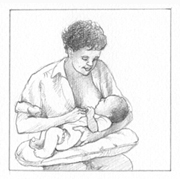
This is the first hold many mothers will try, often soon after their babies are born. To start, cradle your baby’s head in the crook of your arm with your baby’s nose opposite your nipple. Use that hand to support your baby’s bottom. Turn your baby on his or her side, so that your baby is belly to belly to you. Then, raise your baby to your breast. You can support your breast with your other hand.
The Cross-Cradle or Crossover Hold
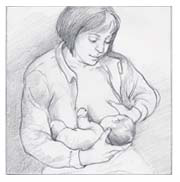
This hold is similar to the cradle hold, but your arms are positioned differently. Instead of supporting your baby’s head in the crook of your arm, use the hand of that arm to support your breast. Your opposite arm should come around the back of your baby. Support your baby’s head, neck, and shoulder by placing your hand at the base of your baby’s head with your thumb and index finger at your baby’s ear level. Like the cradle hold, your baby will be belly to belly to you. You may need to use a pillow on your lap to raise your baby to nipple level.
The cross-cradle position allows you to have more control over how your baby latches on (takes the breast into his or her mouth). Many moms find that they’re able to get their babies latched on more deeply with this hold.
The Side-Lying Position
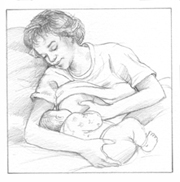
This position is comfortable for mothers who’ve had a cesarean section (C-section) because the baby doesn’t put pressure on the mother’s abdomen. Mske sure that you return your baby to the crib or bassinet before falling asleep.
Start by lying on your side with your baby on his or her side, facing you. Your baby should be positioned so his or her nose is opposite your nipple. Use your lower arm to cradle your baby’s back, or you can tuck a rolled-up receiving blanket behind your baby to help nestle your little one close to you while you use your arm to support your own head. You can support your breast with your other hand.
The Clutch or Football Hold
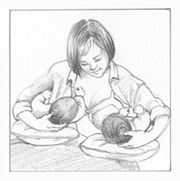
This is also a good position for the mom who’s had a C-section and also for mothers with large breasts or small babies. Mothers with twins who want to feed the babies at the same time may also choose this position.
The football hold allows babies to take milk more easily — which is also good for mothers with a forceful milk ejection reflex (or let down).
To achieve the clutch (or football) hold, place a pillow next to you. Cradle your baby — facing upward — in your arm. Use the palm of your hand on that same arm to support his or her neck, and nestle your baby’s side closely against your side. Your baby’s feet and legs should be tucked under your arm. Then lift your baby to your breast.
Latching On
After your baby is positioned correctly, make sure he or she latches on properly:
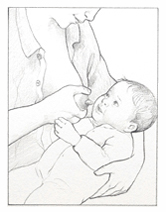
- Make sure your baby’s mouth is opened wide and his or her tongue is down when latching on.
- Support your breast with your hand, positioning your thumb on top and your fingers at the bottom, keeping your thumb and fingers back far enough so that your baby has enough of the nipple and areola (the dark circle of skin around the nipple) to latch onto.
 Gently glide your nipple from the middle of your baby’s bottom lip down to his or her chin to help prompt your baby to open his or her mouth.
Gently glide your nipple from the middle of your baby’s bottom lip down to his or her chin to help prompt your baby to open his or her mouth.- When your baby opens his or her mouth wide and the tongue comes down, quickly bring your baby to your breast (not your breast to your baby). Your baby should take as much of the areola into his or her mouth as possible, with more areola showing at the top lip than at the bottom.
- Make sure your baby’s nose is almost touching your breast (not pressed against it), his or her lips are turned out (or flanged), and you see and hear your baby swallowing. (You should be able to tell by seeing movement along your baby’s lower jaw and even in your baby’s ear and temple.)

When properly latched on, you may have 30 to 60 seconds of latch-on pain (this is caused by the nipple and areola being pulled into your baby’s mouth), then the pain should subside. It will then feel like a tug when your baby is sucking. If you continue to feel pain, stop feeding momentarily and reposition your baby on your breast.
Your baby should give four to five sucks, followed by a 5- to 10-second pause. Your baby’s sucks will increase in number as the quantity of your milk increases. As the milk flow slows, your baby’s pattern will probably change to three or four sucks and pauses that last longer than 10 seconds.
Breaking the Suction
Most babies will release the breast on their own. If your baby doesn’t release your breast but the sucks now seem limited to the front of his or her mouth, you can slip your finger in the side of your baby’s mouth (between the gums) and then turn your finger a quarter turn to break the suction. Then, try to burp your baby and switch him or her to the other breast.
If your baby consistently latches on improperly, sucking on your nipple without getting much of your areola in the mouth, you’ll probably feel discomfort throughout each feeding. Some moms say it’s painful or feels like a pinch as their babies nurse.
Babies who tend to latch on incorrectly will also fall asleep often at the breast and may not seem satisfied because they may not be getting enough. If either of these happens, break the suction and reposition your baby onto your breast to include the nipple and areola.
Call your child’s doctor or a lactation consultant if:
- you can’t nurse your baby without pain
- your baby often falls asleep at the breast
- your baby is nursing but doesn’t seem satisfied when feedings are over
How Can I Tell if My Baby Gets Enough to Eat?
Your baby’s diapers are excellent signs of whether your breastfed baby is getting what he or she needs. Because the first milk your newborn gets (known as colostrum) is concentrated, your baby may have only one or two wet diapers until your milk comes in, which is usually about 3 or 4 days after the birth.
After 4 days, here are some signs to look for:
- six or more wet diapers per day, with clear or very pale pee
- two or more yellow, seedy bowel movements per day, usually one after each feeding through 4 weeks of age. After about a month, breastfed babies usually have fewer bowel movements and many may not have one every day.
Your breastfed baby is also probably getting enough if he or she:
- seems alert and content
- is steadily gaining weight
- feeds between eight to 12 times per day
(This is a good guideline to use early on, usually during about the first month because frequent feedings will help stimulate your milk production. Once your milk supply is established, breastfeeding should be on demand — when your baby is hungry — about every 1 to 4 hours. But remember, your infant may feed every hour for a stretch, then sleep a good 4 to 5 hours, if you’re lucky.)
Sucking for Comfort
If your baby seems to be getting enough milk, but continues to suck for an hour or more, your little one might be nursing for comfort rather than for nourishment. So, how do you know? Once your baby has fed well, he or she may stay on your breast but:
- seem satisfied
- stop sucking and swallowing
- play with your nipple
If your baby is showing these signs of non-nutritive sucking (or pacifying), you may want to offer your infant his or her thumb or hand to suck on. You could also consider giving your little one a pacifier, but only do this after breastfeeding is well established (usually after 1 month).
Looking Ahead
Nursing can be one of the most challenging but rewarding experiences you’ll have as a mother. As you become more used to breastfeeding your baby, you can try different positions or vary the four basic ones.
Experiment with the different holds until you find a position that lets your baby nurse successfully and allows you to feel comfortable. You and your baby will soon find that nursing can be a relaxing, great way to bond.
